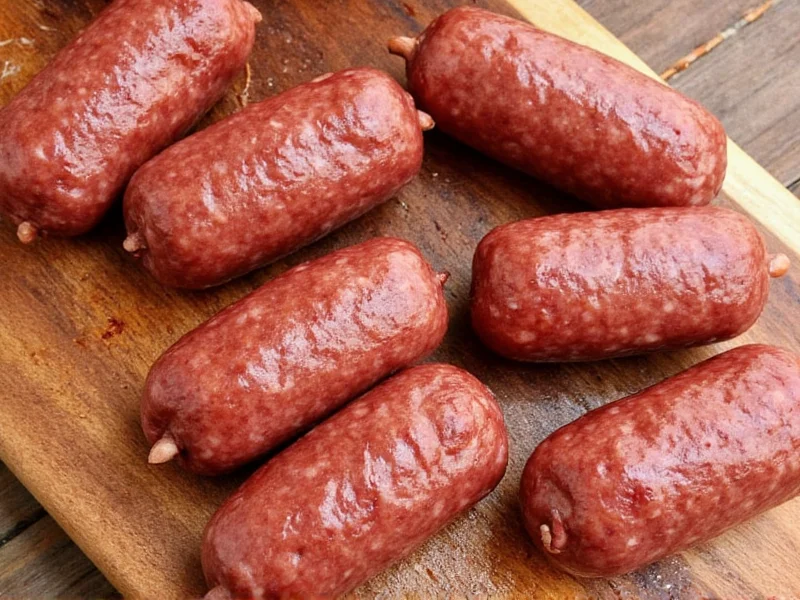The Complete Guide to Perfect Deer Sausage Recipes
Creating exceptional deer sausage transforms lean venison into a flavorful, juicy product that hunters and food enthusiasts love. Unlike commercial sausages, homemade deer sausage requires specific techniques to overcome venison's naturally lean composition while highlighting its distinctive gamey flavor.Why Deer Meat Makes Excellent Sausage
Deer meat's rich, earthy flavor profile provides an ideal canvas for sausage making, but its leanness (typically 2-5% fat content) presents unique challenges. Properly formulated deer sausage recipes compensate for this by incorporating complementary fats while preserving the distinctive venison taste that makes homemade deer sausage recipes so prized among hunters.
Essential Equipment for Deer Sausage Making
Successful sausage production requires specific tools that most home kitchens lack. Invest in these essentials:
| Equipment | Purpose | Alternative |
|---|---|---|
| Meat grinder | Proper texture development | Food processor (less ideal) |
| Stuffer attachment | Filling casings evenly | Manual stuffer |
| Smoker or oven | Controlled cooking environment | Stovetop pan |
| Instant-read thermometer | Food safety monitoring | Digital probe thermometer |
The Perfect Deer Sausage Ratio Formula
Understanding the critical meat-to-fat ratio separates good venison sausage making instructions from exceptional ones. While traditional pork sausages use 70% lean to 30% fat ratios, venison requires additional fat supplementation:
- Basic ratio: 70% venison, 30% pork fat or bacon
- Summer sausage: 65% venison, 35% pork fat with 3% cure
- Breakfast patties: 60% venison, 40% pork shoulder
Never exceed 35% fat content, as this overwhelms venison's distinctive flavor. The fat must remain cold (below 35°F) during grinding to ensure proper emulsification.
Traditional Deer Sausage Recipe
This foundational recipe yields approximately 5 pounds of sausage, perfect for deer and pork sausage mixture enthusiasts:
Ingredients
- 3.5 lbs lean venison (chilled)
- 1.5 lbs pork shoulder or bacon (chilled)
- 1 tbsp non-iodized salt
- 2 tsp freshly ground black pepper
- 1 tsp garlic powder
- 1/2 tsp onion powder
- 1/2 tsp curing salt (Prague Powder #1)
- 1/4 cup ice-cold water or broth
- Hog casings (2-3 inches diameter), soaked
Step-by-Step Instructions
- Cut meats into 1-inch cubes and chill to below 35°F
- Grind through coarse plate (1/2 inch) into chilled bowl
- Re-chill mixture for 20 minutes
- Grind again through fine plate (1/4 inch)
- Mix in seasonings and cold water gradually
- Test fry a small patty to adjust seasoning
- Stuff mixture into prepared casings
- Smoke at 225°F until internal temperature reaches 160°F
Flavor Variations for Unique Deer Sausage Recipes
Experiment with these popular traditional deer sausage seasoning blend variations:
Smoked Maple Breakfast Sausage
Add 2 tbsp pure maple syrup, 1 tsp rubbed sage, and 1/2 tsp red pepper flakes to basic recipe. Form into patties and pan-fry until golden brown.
Spicy Jalapeño Cheddar Sausage
Incorporate 1 cup shredded sharp cheddar and 2 finely diced jalapeños (seeds removed). Perfect for grilling or adding to southwestern dishes.
Italian-Style Venison Sausage
Mix in 2 tsp fennel seeds, 1 tsp dried oregano, 1/2 tsp red pepper flakes, and 1/4 cup red wine. Ideal for pasta dishes or pizza toppings.
Critical Cooking Techniques for Perfect Results
Master these techniques to avoid common pitfalls in curing deer sausage properly:
- Temperature control: Maintain meat below 35°F during preparation to prevent fat smearing
- Binding test: Fry a small patty before stuffing to verify seasoning and texture
- Smoke ring development: Use cherry or apple wood at 200-225°F for optimal flavor
- Internal temperature: Always cook to 160°F minimum for food safety
Troubleshooting Common Deer Sausage Problems
Address these frequent issues with deer sausage recipes:
Dry or Crumbly Texture
Cause: Insufficient fat content or overcooking
Solution: Increase pork fat to 35% and monitor internal temperature carefully
Meat Separating from Casings
Cause: Poor emulsification or air pockets
Solution: Ensure thorough mixing and prick casings to release air bubbles
Bland Flavor
Cause: Inadequate seasoning or improper curing
Solution: Always test fry before stuffing and use proper curing salt measurements
Storage and Preservation Methods
Properly store your storing homemade deer sausage creations:
- Refrigeration: Fresh sausage lasts 3-4 days in coldest part of refrigerator
- Freezing: Vacuum-seal portions for up to 12 months at 0°F
- Smoking: Fully cooked smoked sausage keeps 2 weeks refrigerated
- Canning: Pressure can for shelf-stable storage up to 1 year











 浙公网安备
33010002000092号
浙公网安备
33010002000092号 浙B2-20120091-4
浙B2-20120091-4